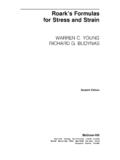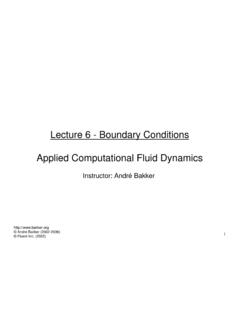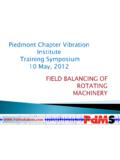Transcription of Effect of Rim Thickness on Symmetric and Asymmetric Spur ...
1 14th National Conference on Machines and Mechanisms (NaCoMM09), NIT, Durgapur, India, December 17-18, 2009 NaCoMM-2009-### 113 Effect of Rim Thickness on Symmetric and Asymmetric spur Gear Tooth Bending stress G. Mallesh1*, Dr. V B Math2, Ravitej3, Krishna Prasad Bhat P3, Paramesh Kumar M K3 1 Assistant Professor, Sri Jayachamarajendra College of Engineering, Mysore-570006, India 2 Professors, Basaveshwar Engineering College, Bagalkot-587101, India 3 Research Group, Sri Jayachamarajendra College of Engineering, Mysore-570006, India (Email: ) Abstract Thin rim gears find application in high-power, lightweight aircraft transmissions.
2 Bending stresses in thin rim spur gear tooth fillets and root areas differ from the stresses in solid gears due to rim deformations. Rim Thickness is a significant design parameter for these gears. The rim Thickness factor is used in the situations in which a gear is made with a rim and spokes rather than a solid disc. Under these circumstances, failure can occur across the rim rather than through the tooth root. An Asymmetric spur gear drive means that larger and smaller pressure angles are applied for the driving and coast sides. The two profiles of a gear tooth are functionally different for most gear drives.
3 The workload on one side of profile is significantly higher than the other Gears. The main objective of this paper is to estimate the critical section for different pressure angles and backup ratios using computer programme and compare the results obtained by other researchers. Developed programme is used to create a finite element model for Symmetric and Asymmetric spur gear tooth to study the Effect of bending stress at the critical section for differ-ent backup ratios. To study the Effect of above parameter ANSYS was used .The rim Thickness was varied and the location and magnitude of the maximum bending stresses were reported and results obtained were com-pared with the Lewis bending equation.
4 Keywords: Backup Ratio, Asymmetric spur Gear Tooth, Finite Element Analysis, Bending stress 1 Introduction Gears are the most common means of transmitting pow-er in the modern mechanical engineering world. A gear can be defined as a machine element used to transmit motion and power between rotating shafts by means of progressive engagement of projections called teeth. Gears have a wide variety of applications which vary from a tiny size used in watches to the large gears used in lifting mechanisms and speed reducers. They form vital elements of main and ancillary mechanisms in many machines such as automobiles, tractors, metal cut-ting machine tools etc.
5 In recent times, the gear design has become a highly complicated and comprehensive subject. A designer of a modern gear drive system must remember that the main objective of a gear drive is to transmit higher power with comparatively smaller overall dimen-sions of the driving system which can be constructed with the minimum possible manufacturing cost, runs reasonably free of noise and vibration, and which re-quired little maintenance. He has to satisfy, among oth-ers the above conditions and design accordingly, so that the design is sound as well as economically viable.
6 Present day gears are subjected to the different types of failures like fracture under bending stress , surface failure under internal stress major cause of gear failure is fracture at the base of the gear tooth due to bending fatigue. Design models for this mode of failure use a parabolic beam with stress concentration correction. The bending strength is influenced by: the gear size, described by the diametral pitch; the shape of the tooth, described by the number of teeth on the gear; the highest location of the full load, described by the number of teeth on the mating gear; and the fillet geometry of the gear tooth.
7 For thin rim gears, the Thickness of the rim is another significant factor which influences the bending strength of the gear. Rim deflections increase the bend-ing stresses in the tooth fillet and root areas. Therefore in aircraft applications, the rim Thickness and allowable stress are optimized to achieve light weight. Wilcox and Coleman applied the finite element method to analyze the bending stresses in a gear tooth of a solid gear and demonstrated good agreement with photoelas-tic stress measurements. For thin rim gearing, Drago et al. studied rimmed gear stresses experimentally with strain gages and photoelastic models and analytically with two and three-dimensional finite element models.
8 Their studies report a nearly constant bending stress as the rim Thickness decreases and a sudden increase in bending stress below a certain rim Thickness . Analytical studies have been conducted on thin rim gear stresses with finite elements by several researchers. Oda et al. 14th National Conference on Machines and Mechanisms (NaCoMM09), NIT, Durgapur, India, December 17-18, 2009 NaCoMM-2009-ASMG23 114studied a single tooth model of a thin rim spur gear us-ing a five tooth segment fixed at its sides. They used strain gages to verify their results. Arai et al.
9 Studied a spoked thin rim gear with four teeth in the free rim arc between spokes. Chang et al. applied a two-dimensional finite element grid to a single thin rim tooth with fixed constraints at the tooth sides to demonstrate the stress distribution in the tooth. Chong et al. used two dimen-sional triangular finite elements and a rack model to study the effects of the rim on the bending stress in the fillet. Their rack model had statically determinate beam supports on segments of different lengths. Von Eiff et al. used a finite element model of a three tooth segment for both external and internal gears to study the maximum bending stresses at the root of the central tooth.
10 Gulliot and Tordion analyzed the problem of a thin rim on a support hub using the finite element method. All of these studies report a nearly constant tensile bending stress as the rim Thickness decreases to a value near the tooth depth. The tensile root stress increases rapidly with further reductions of rim Thickness . However, each study reported a different transition rim Thickness value. These studies also differed in the rim support geometry and the number of teeth on the gear. The ring flexibility of the rim influences both the tooth stiffness 11and the location and magnitude of the maximum bending stress in a thin rim gear.







